In vitro Morphogenesis of Cosmos atrosanguineus
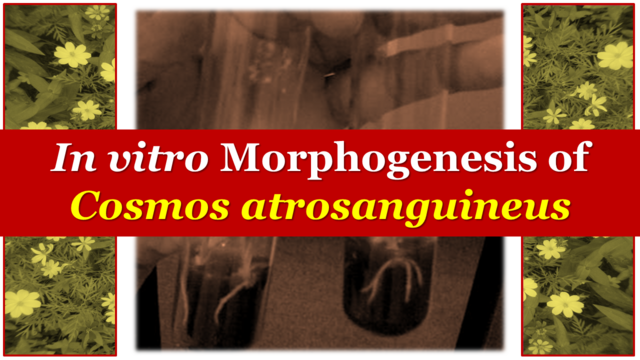
This post will serve to socialize with the entire academic community of the STEEM ecosystem, different biotechnological techniques used in plant production, in the search for increased crop yields. In this contribution we will address everything related to the in vitro cultivation of Cosmos atrosanguineus (ASTERACEAE).
Introduction
The production systems used in modern agriculture are the result of multidisciplinary approaches, which, in addition to considering traditional agronomic management techniques, incorporate biotechnological tools in the search for mass production in the field, and thus guarantee the growing demand for food for the world's overpopulation [1].
Within biotechnological tools, in vitro cultivation is a plant propagation technique, where clones can be obtained from plants that do not propagate naturally (sexual seed), or that are very difficult to propagate by other means of multiplication (cuttings, grafting, layering, among others). This dynamic and innovative biotechnological scenario makes it possible to obtain large quantities of seedlings from plant segments commonly called explants, with the capacity to regenerate a complete plant that is genetically identical (clone) to the plant that originated it [2].
However, considering that the in vitro culture technique represents a practical application of plant cloning and multiplication, the objective of this post is to socialize an experimental trial of in vitro propagation of specimens of Cosmos atrosanguineus (Asteraceae) .
Growth phytohormones
The success of any in vitro culture depends on the incorporation of growth hormones as a method to induce vegetative multiplication, because phytohormones are chemical substances produced by tissues in a natural way, which have one or more highly specific effects at an organographic level, such as growth, development and metabolic activities [3]:
Auxins
To this group of chemical substances, they are known as growth phytohormones, and the collective name assigned is auxin, word that comes from the Latin Auxin or to grow, also they are usually called Indolacetic Acid or AIA, these phytohormones initially were isolated of vegetable tissues, nevertheless, at the present time they are synthesized in specialized laboratories, on the other hand, it is important to mention that the auxins participate in multiple answers of the plants, among which, the phototropic action in the formation of roots, is the mechanism most used in the vegetable biotechnology [3].
Among the main functions of the auxins, the following are mentioned; apical dominance, increase stem growth, promote cell division in vascular cambium and differentiation of secondary xylem, stimulate the formation of adventitious roots, stimulate fruit development (parthenocarpic sometimes), favor phototropism, promote cell division, promote flowering in some species, promote ethylene synthesis (influence in fruit ripening processes), favor fruit setting and ripening and inhibit fruit fall.
Cytokinins
These vegetal phytohormones, are characterized by their specificity to stimulate the cellular division in non meristematic tissues, initially they were called quinines, however, due to the inner use of the name for a group of compound for the animal physiology, the term cytokinin (cytokinesis or cellular division) was adopted, of this phytohormone the most used substance in the vegetal biotechnology is the Benzil amino purine (BAP) .
Cytokinins are produced in growth areas such as meristems, that is, in the tips of the roots and stems, on the other hand, the highest concentrations of cytokinins are found in embryos and young developing fruits.
Gibberellins
The main effect of the phytohormones gibberellins is to stimulate the longitudinal growth of the stem, so probably dwarfism is a disorder that prevents the formation of gibberellins, hence, the application of these substances to dwarf plants corrects this defect, likewise, it has been raised that gibberellins also stimulate premature flowering, in addition to acting on the formation of parthenocarpic fruits, interrupting the dormancy of certain tubers and some seeds [4] .
In vitro morphogenesis
Within plant biotechnology, in vitro morphogenesis is nothing more than the cultivation of plant segments in controlled artificial environments, whose fundamental characteristics are determined by the use of culture media rich in inorganic salts, organic compounds and vitamins.

Fig. 2 Cosmos atrosanguineus seedlings, growing in test tubes - MS and 0.5 mg.L-1 ANA. Author: @lupafilotaxia.
Growing medium
A culture medium is the formulation of inorganic salts and organic compounds required for the nutrition and handling of crops. Within the numerous formulations, each one can be made up of up to 40 compounds.
Vitamins
According to [3], vitamins are organic compounds necessary for the normal metabolism of certain living organisms, resembling the enzymes or hormones that the organism needs in really minimal quantities for its normal growth and development, however, as far as plant biotechnology is concerned, the vitamins used in culture media are recorded; B-complex group or water-soluble, which are:
Thiamine (B1): essential organic compound of the coenzymes that catalyze the oxidation of pyruvic acid in the respiratory cycle, which is why, without this vitamin, living cells cannot perform their vital functions.
Riboflavin (B2): vitamin necessary for the elongation of the roots, and biological action in the apical dominance.
Niacin (B12): this organic compound plays an important role in cellular respiration, being part of coenzymes I and II, which are hydrogen-carrying groups in the respiratory phase of dehydrogenation.
Ascorbic Acid (Vitamin C): intervenes in the oxidation systems of the cell and establishes favorable oxidation-reduction potentials, it also reduces oxidized tannins in vitro or on the surface of freshly cut fruits.
Histological fragments
Explants
Explants are histological fragments of diverse nature, they can be portions of tissue, loose cells, protoplasts, spores, pollen grains or seeds, hence, the type of explant to be used in in vitro culture processes depends on the species being manipulated, and the objectives pursued [2] .
However, from the biological point of view, explants are meristematic apical and axillary genetically stable portions, used in plant biotechnology to produce multiple clones with special characteristics that are desired to maintain in the crop, however, there are genetically unstable explants, within these, those obtained from adventitious buds, basically this type of segments produce a high degree of variability in the clones, an element not so useful for the production of seedlings with a certain crop characteristic .
Biotechnological testing
Species and area of study
With the purpose of socializing some techniques used in plant biotechnology, I will share with all of you an experimental procedure on in vitro culture, in specimens of Cosmos atrosanguineus (Asteraceae) commonly known as Chocolate Flower, the trial was developed in the laboratory of Agricultural Botany of the UNEUSR, university institution located in Santa Barbara de Zulia - Venezuela.
Methodological approach
In order to be able to induce rooting in vitro in Cosmos atrosanguineus seedlings, C. atrosanguineus shoots were multiplied in Murashige and Skoog salts used experimentally as culture media [6], the composition used was; sucrose 30 g.L-1, 2 mg.L-1 of BAP, 7 g.L-1 of powdered Agar adjusted the medium to pH 5.8. After the formation of C. atrosanguineus sprouts at a height of 1 cm, the rooting phase was initiated. For this purpose, each vegetative material was placed in the culture media considered (T1: DM and 0.5 mg.L-1 of ANA., T2: DM in 0.5 mg.L-1 of AIB., and T3: DM in 1 mg.L-1 of AIB) and on a shelf with neon light, photoperiod of 16 light hours and controlled temperature at 28 °C. Finally, and in order to determine the effectiveness of the in vitro culture media subject to evaluation, the number of leaves, number and length of roots, height of seedlings, rooted and non-rooted material, and contaminated seedlings were counted.
Experimental unit
For the purpose of this study, the experimental unit was represented by 15 vegetative shoots of Cosmos atrosanguineus,distributed in 3 treatments, designed to compare the in vitro behavior in C. atrosanguineus seedlings, submitted to culture media and whose composition of ANA and AIB phytohormones oscillated between 0.5 and 1 mg.L-1.
Materials and reagents used
- Vegetative shoots of Cosmos atrosanguineus
- Test tubes
- Micropipettes
- Laminar flow chamber
- Petri dishes
- Scalpels
- Autoclave
- Shaking plate
- Phytohormones / Vitamins / Agar powder
Biotechnological results
Rooted and non-rooted vegetative material
As for rooting, T1 presented the highest number of rooted seedlings compared to the other treatments, registering 5 rooted plants, while T2 obtained 2, and T3 registered 3 rooted seedlings.
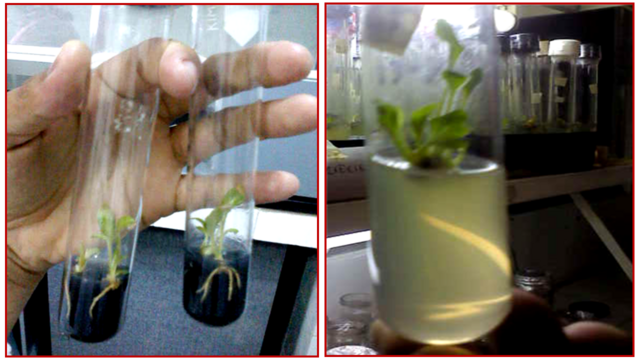
Fig. 3 On the left, rooted seedlings of Cosmos atrosanguineus, on the right unrooted material. Author: @lupafilotaxia.
Number and length of roots
In relation to the number and length of roots, a similar behavior was obtained to that registered in the initial phase with the variable number of leaves, that is to say, the formation of roots was similar between the treatments, this indicates, that the growth of roots in Cosmos atrosanguineus seedlings, responds indifferently to the application or not of the regulators ANA and AIB.
Number of sheets
In the three culture media considered, 1 to 3 initial leaves were recorded during the rooting phase under in vitro conditions, however, after 14 days the number of leaves emitted showed differences between treatments, with T1 expressing the highest values (6 leaves), compared to T3 which presented the lowest number of leaves emitted (4 leaves), a response that is probably associated with a higher concentration of AIB.
Seedling height
Dissimilar behavior to the first two records, was obtained in the variable height of Cosmos atrosanguineus seedlings, showing T1 the best response (4 cm), compared to T2 and T3 that recorded average values around 2.5 cm in height.
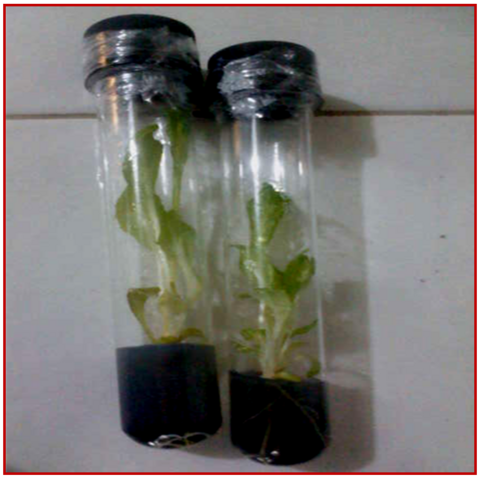
Fig. 4 On the left, Cosmos atrosanguineus seedlings in T1 test tubes, on the right seedlings in T3 test tubes. Author: @lupafilotaxia.
Contaminated seedlings
With respect to Cosmos atrosanguineus seedlings, dead due to contamination, the T2 and T3 treatments showed a greater number of shoots and means with this condition, an aspect that is probably related to an inadequate handling of vegetative shoots at the time of selection, or in its absence, to biosecurity problems in the Agricultural Botany laboratory.
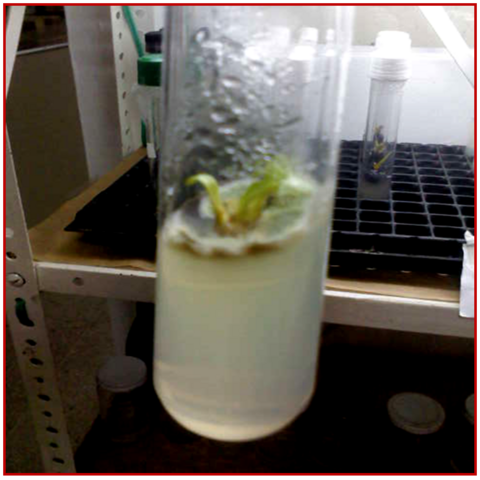
Fig. 5 Contaminated Cosmos atrosanguineus seedlings. Author: @lupafilotaxia.
SCIENTIFIC CONTRIBUTIONS OF THIS PUBLICATION
- The information socialized in this post, incorporates conceptual and technical elements to the Steem platform, related to plant biotechnology, among these; key aspects on the method of plant propagation by in vitro culture, in addition to the mechanism of action presented by the growth phytohormones, the importance of culture media and morphogenesis in vitro, the function of histological fragments specifically of apical explants, without ignoring, the scientific contribution of the results obtained in the biotechnological test, when determining the viability of the Murashige and Skoog culture media for the effective multiplication of Cosmos atrosanguineus shoots, in addition to the high percentage of in vitro rooting, obtained when applying auxinic regulators based on ANA at low concentration (0.5 mg.L-1). As in previous manuscripts, the audiovisual exhibition and narration of implicit content in the manuscript, increases the botanical resources for its socialization in multimedia formats.
BIBLIOGRAPHICAL REFERENCES CONSULTED AND CITED:
[1] Calva G., y Pérez J. Cultivo de células y tejidos vegetales: Fuente de alimentos para el futuro. Revista Digital Universitaria. 2005;6:11. Article: Online access
[2] Roca W., y Mroginski L. Cultivo de tejido en la agricultura: fundamentos y Aplicaciones. Cali, Colombia. CIAT. 1991;45-63. Article: Online access
[3] Curtis B., y Schenek M. El crecimiento y desarrollo en las plantas: Mensajeros internos: las hormonas vegetales. Biología 7ma Edición. Editorial Panamericana. 2007. Article: Online access
[4] Fuentes J. Botánica Agrícola. Capítulo VIII crecimiento y desarrollo de los vegetales superiores. 5ta edición. Ediciones Mundiprensa. Madrid-España. 1998;95-100. Article: Online access
[5] Concepción O., Nápoles L., Pérez A., Peralta N., y Trujillo R. Regeneración de brotes adventicios en hojas de guayaba (Psidium guajava L.) cultivadas in vitro. Revista Colombiana de Biotecnología. 2004;6;2:54-61. Article: Online access
ATTENTION / Readers and Followers
If you want to read more scientific articles of excellent academic quality, do not waste time, and visit the label #steemSTEM, is a large community that values and promotes scientific content, mainly in the areas of Science, Technology, Engineering and Mathematics.

INVITATION
Dear reader, if you wish to obtain more information about it, join our server in Discord
OBSERVATIONS
✔ The POST ⌨ ✍ ✉ was uploaded using the official app of https://www.steemstem.io
OBSERVATIONS
✔ The POST ⌨ ✍ ✉ was uploaded using the official app of https://www.steemstem.io
You can visit the official app of our community
https://www.steemstem.io
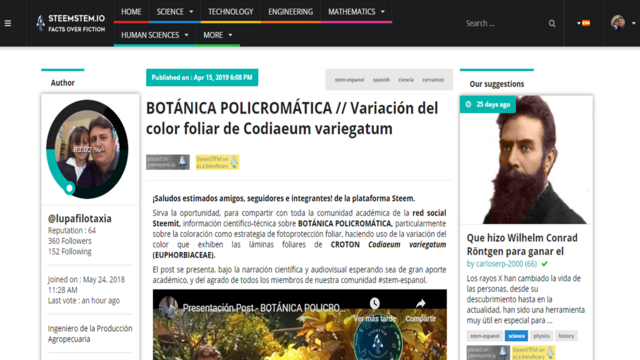

@tipu curate
Upvoted 👌 (Mana: 0/4 - need recharge?)
Thank you for your support.
Link to the contribution on Twitter: https://twitter.com/lupafilotaxia/status/1235748565961629696
Esta publicación ha sido seleccionada para el reporte de Curación Diaria.
Thank you for your support.
De nada cariño, estamos para apoyar. Saludos.
Congratulations @lupafilotaxia! You have completed the following achievement on the Steem blockchain and have been rewarded with new badge(s) :
You can view your badges on your Steem Board and compare to others on the Steem Ranking
If you no longer want to receive notifications, reply to this comment with the word
STOPDo not miss the last post from @steemitboard:
Thank you for the notification.
You're welcome @lupafilotaxia
Feel free to support us back: vote for our witness.
You will get one more badge and more powerful upvotes from us on your posts with your next notifications.
There, I made my manual vow again, I included @steemitboard among my witnesses.
Congratulations, your post has been upvoted by @dsc-r2cornell, which is the curating account for @R2cornell's Discord Community.
This post has been voted on by the SteemSTEM curation team and voting trail. It is elligible for support from @curie and @minnowbooster.
If you appreciate the work we are doing, then consider supporting our witness @stem.witness. Additional witness support to the curie witness would be appreciated as well.
For additional information please join us on the SteemSTEM discord and to get to know the rest of the community!
Thanks for having used the steemstem.io app and included @steemstem in the list of beneficiaries of this post. This granted you a stronger support from SteemSTEM.
Excellent material @lupafilotaxia thanks for this